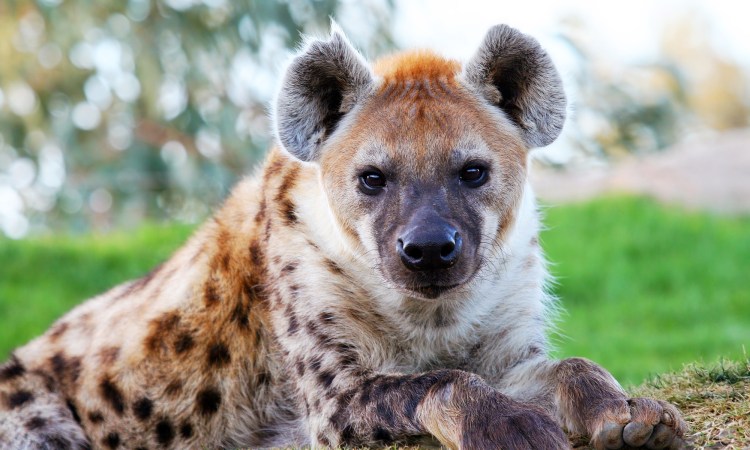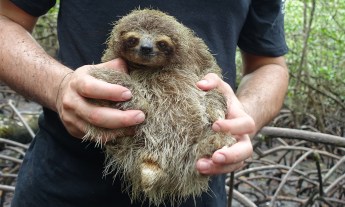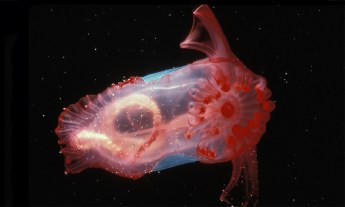
Don’t be misled by the cringing creatures seen in The Lion King. From their biology to their social structure, spotted hyenas are complex creatures like none other on earth, explains author and zoologist Lucy Cooke.
In the animal world, the hyena has been censured by more scandalous untruths than even the sloth. They are considered nature’s thugs — condemned throughout history and across cultures and continents as dim-witted cowards, skulking in the back alleys, waiting for an opportunity to mug other, more noble, animals of their dinner.
Among the four species of hyena, the largest, most widespread and most misconstrued of is the spotted hyena, Crocuta crocuta. With its scrappy fur, hunched back and wide, drooling grin, this so-called laughing hyena may not be the prettiest of animals. But our disdain goes more than skin deep; it’s personal.
The hyena’s bewildering biology is partly to blame. Here is an animal that looks and hunts like a dog but is in fact a souped-up member of the mongoose family and therefore more closely related to a cat. Over the course of several editions of his tome, Systema Naturae, zoologist Carl Linnaeus classified the hyena first as a cat, then later as dog. He never got it right.
Even more baffling than what kind of animal the hyena is, was the basic question of its gender. “It is the vulgar notion, that the hyæna possesses in itself both sexes, being a male during one year, and a female the next,” wrote Pliny the Elder in his animal encyclopedia. The Roman naturalist wasn’t the first — or the last — to suggest the hyena was a hermaphrodite. The rumor was rife in African folklore and debated by Aristotle. But while modern science has identified more than 65,000 known cross-sexual species, the hyena is not one of them.
The clitoris of female spotted hyenas extends almost eight inches, and it can even get an erection.
The likely stimulus for this myth is the female spotted hyena’s wildly unconventional genitalia, which are a near perfect facsimile of the male’s. A Crocuta’s clitoris extends almost an impressive eight inches and is shaped and positioned exactly like a penis, hence known in polite biological circles as a “pseudo-penis.” They can even get erections. To complete this trans-trickery, the female spotted hyena also appears to sport her very own pair of testicles: Her labia have fused to form a false scrotum and are filled with fatty-tissue swellings, which are quite understandably mistaken for male gonads. Paul A. Racey and Jennifer D. Skinner, authors of a paper on sexual mimicry in the spotted hyena, declared the appearance of males and females “so close that sex could only be determined with certainty by palpation of the scrotum.”
What’s more, the female spotted hyena is the only known mammal with no external vaginal opening. Instead, she must urinate, copulate and give birth through her multi-tasking pseudo-penis. This last eye-watering feat is like squeezing a cantalope out of a hosepipe, and 10 percent of first-time hyena mothers die in the process. The fate of their cubs is even more precarious, since the umbilical cord is too short to navigate a birth canal that’s not only twice the length of a similar-sized mammal’s but includes a cheeky hairpin turn halfway down. Up to 60 percent of cubs suffocate on their way out. It is easy to see how the sight of a “male” hyena giving birth through his penis led to the hermaphrodite myth (as well as a few lingering nightmares).
The female’s gender-bending doesn’t end with her fake phallus. Spotted hyenas are unlike all other mammals in that the females are significantly bigger than the males and much more aggressive. “You do not want to be a male spotted hyena,” Kay Holekamp, professor of evolutionary biology and behavior at Michigan State University, told me. She’s spent over thirty years studying Crocuta in the wild, painting a fresh portrait of these miscast creatures and earning a reputation as the Jane Goodall of hyenas.
Every hyena clan is a matriarchy ruled by an alpha female. In the clan’s strict power structure, dominance passes down the alpha female’s line to her cubs. Itinerant adult males rank last, reduced to submissive outcasts begging for acceptance, food and sex. At a communal carcass, where 30 or so hyenas might be vying for their pound of flesh, these adult males eat last — if there’s anything left — or risk violent retribution from the sisterhood. Holekamp believes the driver of the female spotted hyena’s aggression and dominance is the intense competition over carcasses. A frenzied scrum of hyenas can turn a 550-pound adult zebra into a bloody stain on the grass in under 30 minutes. In a single feeding, an adult can gobble up to one-third of its body weight, or between 33 and 44 pounds of meat. It’s a frantic, frenzied and, at times, frightening scene. A female that is bigger and meaner has a better shot of ensuring her surviving cubs get a place at the table and don’t get hurt in the process.
Dominant females have another trick for giving their cubs an aggressive advantage. A recent study by Holekamp has shown that the more powerful the female, the more testosterone her fetuses are exposed to during the final stage of pregnancy. These androgens are produced by the mother’s ovaries, which is unusual enough. It is Holekamp’s belief that female cubs are more sensitive to their effects than males are. Spotted hyenas have an unusually long gestation period, and marinating in this prenatal androgen bath affects the development of the cub’s nervous system so they’re wired to fight from the moment they are born. And they already have the necessary weapons: Unlike most mammals, hyena cubs emerge with eyes open, muscles coordinated and teeth already pierced through their gums and eager to bite.
The female hyena’s pseudo-penis may be acting as an “anti-rape” device, allowing her to exercise choice over whom she mates with.
These belligerent newborns frequently fight to the death over dinner, and siblicide is commonplace. Scientists presumed that this superfluity of prenatal testosterone also caused the disproportionate growth of the female hyena’s clitoris. But when the same researchers gave captive pregnant spotted hyenas a diet packed with anti-androgens (which blocked the male sex hormone), female cubs still surprised them by popping out of the birth canal sporting “a large pendulous phallus” and a “normal pseudo-scrotum.”
According to Holekamp, the spotted hyena’s extraordinary sexual equipment remains “one of the most interesting mysteries in biology.” Some scientists have suggested the hyena evolved the pseudo-penis in order that it could be licked by subordinates, which is how female spotted hyenas tend to greet each other (and assess dominance). But Holekamp can’t see how this would be a strong enough evolutionary driving force to create a structure as reproductively damaging as the pseudo-penis.
“I am convinced we can rule out all the hypotheses that have been forwarded in the literature to date: it is definitely not merely a ‘side-effect’ of female androgen exposure, and it is not there to permit greeting behaviors,” she said. Her educated guess — and it is still a guess — is that the female’s gender-bending is a result of the age-old war between the sexes. Unlike most animals, where the males duke it out and the winner gets the girl, in spotted hyena clans the females dictate the who, where and when of copulation.
Sex is an undignified affair that sees the male forced to squat at the female’s rear, stabbing away blindly in an attempt to insert his erect actual penis into her floppy, half-foot pseudo-penis. It’s a bit like the male’s trying to have sex with a sock — a pretty tricky exercise that’s completely impossible without the female’s full cooperation. Brute force alone simply won’t work, as it does in many other animals. The female hyena’s pseudo-penis may be acting as an “anti-rape” device, allowing her to exercise choice over whom she mates with. This is pretty handy because, in addition to the dangers lurking in her precarious birth canal, a spotted hyena suffers a few other reproductive challenges. Her ovaries have comparatively little follicular tissue and produce relatively few eggs, and so it pays for her to be picky.
You’d never imagine this was the strategy from observing her behavior, since female spotted hyenas are highly promiscuous. Holekamp reckons the pseudo-penis allows the female to choose not just whom she mates with but, more impressively, who actually fertilizes her precious eggs by acting as a form of built-in birth control. That strangely elongated reproductive tract, with its various twists and turns, slows down sperm as they swim towards their goal. If the hyena changes her mind about a male after mating, she simply flushes out his semen by urinating. Go, sister!
I wonder whether this new image of the spotted hyena as a pioneering feminist, strutting around the savannah with a counterfeit penis, beating up on submissive males and taking control of her sexual destiny, would have been any less sacrilegious to the male bestiary authors than the original hermaphrodite myth. In the hands of these religious scribes, the animal’s suspicious sexuality rendered it “a dirty brute,” and hyenas were frequently used to warn against the evils of homosexuality.
This set the stage for a resolutely damning portrait of the hyena that often included grisly tales of grave robbing. However, only the brown hyena and the striped hyena are primarily scavengers. Spotted hyenas are highly efficient predators, killing 95 percent of the food that they consume. Hunting parties are capable of bringing down aggressive animals, like water buffalo, several times their size. Even lone hyenas have been known to catch impressively large prey — one bold strategy being to lock on to the animal’s testicles and hang on until the victim bleeds out. Such tactics are not for the faint-hearted, yet somehow hyenas have an enduring reputation for being a bunch of wimps.
“All writers agree that the hyaena lacks courage,” wrote the naturalist John Nott in 1886. This rumor can be traced back to Aristotle, who developed an arcane theory about how bravery could be predicted by the size of an animal’s heart. He lumped the hyena, somewhat incongruously, in with “the hare, the deer, the mouse,” along with “all other animals that are either manifestly timorous, or that betray their cowardice by their spitefulness” for having a disproportionately large heart.
Field studies have found that lions actually steal more kills from spotted hyenas than vice versa.
The idea that hyenas are cowards has persisted well into the modern age. On safari one misty morning near Lake Nakuru, Kenya, I caught up with a pack of spotted hyenas hunting a zebra, their favorite prey. It was a tough watch. When I arrived, the hyenas had already ripped the hide from the right flank of the zebra, exposing the beast’s innards in the manner of a living, breathing Gunther von Hagens anatomical sculpture, as the skin trailed behind the animal like a piece of half-discarded clothing. The hyenas were now following this semi-eviscerated beast, waiting for its inevitable collapse. It was hard not to anthropomorphize the actors before me: the zebra seemingly dignified in the face of death, the hyenas cruel and cowardly.
But survival is an unsentimental sport, and the hyena’s hunting strategy is based on endurance. It often involves “testing” prey to see how much fight they have left, which could be interpreted as timidity but is better understood as a key part of their winning long game. There’s no point risking fatal injury from a kick or a claw when all you need is patience.
The idea that hyenas spend their time sneaking about and stealing the spoils from more “noble” animals like the lion is another misconception. Field studies have found that lions actually steal more kills from spotted hyenas than vice versa. The animosity between the animals is, however, very real: These two species are arch enemies, locked in battle over territory and food. While lions may have the size advantage, the hyena makes up for this with intelligence. “Lions are not the sharpest tools in the shed,” as Holekamp put it.
The hyena is a pathetic fool in The Lion King, but these feminist freaks are the brains of the savannah — and smarter than your average carnivore. A few years ago, I got to spend a couple of days watching spotted hyenas in the Maasai Mara with Sarah Benson-Amram, an expert in hyena intelligence. “I think their reputation for being stupid has a lot to do with their gait,” she told me. “They have this sort of lope which is very beneficial in terms of being superefficient runners, energy-wise; they can run really long distances. But it gives them this sort of awkward, dopey appearance.”
To find the truth, Benson-Amram invented the world’s first carnivore IQ test — a metal puzzle box with a meaty treat trapped inside that can only be released by using brains, not brawn. She has plonked her puzzle box before various predators from polar bears to panthers to gauge their problem-solving skills. She discovered that the animals that performed well tended to share a rich social life and believes sociability could be the evolutionary force responsible for the hyena’s superior intellect.
Spotted hyenas gather in social groups bigger than any other carnivore — their packs can number up to 130 individuals and they’ve been observed defending territories of up to 620 square miles. They live by the clan, and everything they do is tied up with the female dominance hierarchy that underpins it, but they don’t remain together all the time. Instead, they spend much of their time in smaller splinter groups that coalesce in order to fight, hunt or feed.
This arrangement is known as a fission-fusion society, and maintaining it demands sophisticated communication skills. Aristocratic French naturalist Georges-Louis Leclerc, Comte deBuffon, dismissed the hyena’s calls as simply sounding like “the sobs or reachings of a man in a violent fit of vomiting.” But spotted hyenas have one of the richest vocal repertoires of any terrestrial mammal, including primates. They make a wide range of sounds including that famous giggle (actually a sign of submission), but the whoop — a quintessential sound of the savannah — is their signature call. It is a ghostly echo that can carry on the wind for up to three miles, transporting with it a wealth of information about the caller, including its identity, sex and age.
Hyenas’ big brains enable them to recall each member’s voice and status, ensuring they have the political savvy to recognize friend from foe and negotiate their strict social hierarchy.
Hyenas’ big brains have evolved to memorize the identity and rank of each of their clanmates. They also appear to be able to recall each member’s voice and status throughout their lives — no mean cognitive feat, and one that ensures they have the political savvy to both recognize friend from foe in a single call and negotiate their strict social hierarchy, without endless conflict. And Benson-Amram has found that hyenas respond differently depending on whether they hear the whoops of one, two or three individuals.
This means the spotted hyena sisterhood can, in some sense, count — a useful tool when trying to gauge whether to fight a rival gang. She has also shown that rival hyena clans will use their numeracy and communication skills to band together and fight off a common enemy, such as the lion. Despite being wired for aggression, spotted hyenas use their intelligence to keep the peace and collaborate. “Hyenas are very cooperative with their clan members and close relatives,” she explained. “You see these sisters and they spend a lot of time together, eating, hunting and resting together, and they have long-term, very close relationships …While they can be very competitive, in many respects they are also very cooperative.”
Ultimately, the hyena’s extraordinary success at bringing down large prey, intimidating lions and raising their cubs in a hostile environment depends on their capacity for teamwork. Recent fieldwork suggests that the social structures of the spotted hyena are every bit as complex as those of baboons, and CT scans have confirmed that hyena brains have evolved in a similar frontal direction to primates, with the region involved in complex decision-making enlarged. They have even out-performed chimpanzees on certain cooperative problem-solving tests.
This supports the idea that living in a complex fission-fusion society — as both chimps and hyenas, along with dolphins, other apes and, of course, humans, do — is key to the evolution of big brains. This may even help explain why our species evolved a brain that is seven times bigger than what would be predicted for an animal our size. This shared portion of the evolutionary path may also provide the ultimate clue to our unswerving contempt for these calculating creatures.
Bones that show cut marks from early stone tools mixed with tooth marks of hyenas suggest hyenas were laughing at humans and stealing our dinner for as much as 2.5 million years.
Humans and hyenas are long-standing enemies. The Australian anthropologist Marcus Baynes-Rock, who has spent several years living in Ethiopia studying the relationship between our two species, has some insights as to why. Both humans and hyenas are highly intelligent social predators with origins on the African savannah, he explained to me. But the hyenas were there first, so when our distant hominin relatives came down from the trees, they were muscling in on the spotted hyena’s patch.
Baynes-Rock thinks the hyena’s bone-crunching bite could even be the reason for the sparse evidence of early human evolution. He said, “Most hominid remains are just teeth and jawbones. When you are finding teeth, it’s almost a guarantee that the dead person has been through the digestive tract of a hyena, because that’s all that comes out.”
Our early ancestors had only very basic stone tools, and were probably scavenging more than they were hunting. They would not have been able to fight off a pack of hungry hyenas to protect their prize meal; a theory borne out by bones from the period that show cut marks from early stone tools mixed with tooth marks of hyenas, suggesting that hyenas were laughing at us and stealing our dinner for as much as 2.5 million years. No wonder we don’t like them.
Excerpted from the new paperback The Truth About Animals: Stoned Sloths, Lovelorn Hippos, and Other Tales from the Wild Side of Wildlife by Lucy Cooke, with the permission of Basic Books, an imprint of Perseus Books LLC, a subsidiary of Hachette Book Group. Copyright © 2018 by Lucy Cooke.
Watch Lucy Cooke’s TEDWomen talk here:















